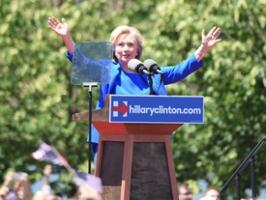Most GOP Voters Still See Trump As Likely Nominee
A Hillary Clinton-Donald Trump matchup still looks like it may be in the cards.
The latest Rasmussen Reports Trump Change national telephone survey finds that 58% of Likely Republican Voters again this week think Trump is likely to be the GOP’s presidential candidate next year, with 22% who say it’s Very Likely. These findings have held steady for three weeks now.
Thirty-six percent (36%) of Republicans say Trump is not likely to make it all the way to the nomination, but that includes only eight percent (8%) who feel it’s Not At All Likely. (To see survey question wording, click here.)
Clinton didn’t get a bump following the first Democratic presidential debate Tuesday night but still holds a two-to-one lead over her closest rival.
Since Rasmussen Reports initiated the weekly Trump Change feature in mid-August, belief among Republicans that he is the likely candidate has ranged from a low of 52% to a high of 66%. But only 27% of GOP voters felt a Trump nomination was likely when he formally announced his candidacy in mid-June.
Among all likely voters, 46% think Trump is likely to be the Republican nominee, but just as many (46%) say that’s unlikely. This includes 18% who see a Trump nomination as Very Likely and 16% who say it is Not At All Likely. This, too, hasn’t changed much in the past three weeks.
(Want a free daily e-mail update? If it's in the news, it's in our polls). Rasmussen Reports updates are also available on Twitter or Facebook.
The survey of 1,000 Likely U.S. Voters was conducted on October 14-15, 2015 by Rasmussen Reports. The margin of sampling error is +/- 3 percentage points with a 95% level of confidence. Field work for all Rasmussen Reports surveys is conducted by Pulse Opinion Research, LLC. See methodology.
As long as the GOP race remains competitive, Rasmussen Reports will continue tracking Trump’s surprisingly successful early run for the White House in a weekly Friday feature we’re calling Trump Change.
Women have more confidence than men that Trump is the likely nominee. Younger voters doubt that more than their elders.
White voters see Trump’s chances as better than blacks and other minority voters do.
Democrats by a 52% to 41% margin think Trump is unlikely to be the GOP nominee. Unaffiliated voters agree by a similar margin.
Voters who think Hillary Clinton is likely to be the Democratic nominee are more likely to believe Trump will not be her rival.
But more voters than ever are convinced that the 2012 incident in Benghazi, Libya in which the U.S. ambassador was killed on her watch will hurt the former secretary of State's bid for the White House.
Voters have a major decision coming up: Who to elect as the next president of the United States. They’ll have to sift through hundreds of conflicting news stories, debate after debate, campaign tours and press conferences. It’s a lot to take in, so how do voters decide?
As House Republicans struggle to find a replacement for Speaker John Boehner, Wisconsin Congressman Paul Ryan, the GOP’s vice presidential nominee in 2012, has emerged as a new favorite, but how does Ryan play with Republicans nationwide?
Additional information from this survey and a full demographic breakdown are available to Platinum Members only.
Please sign up for the Rasmussen Reports daily e-mail update (it’s free) or follow us on Twitter or Facebook. Let us keep you up to date with the latest public opinion news.
The survey of 1,000 Likely U.S. Voters was conducted on October 14-15, 2015 by Rasmussen Reports. The margin of sampling error is +/- 3 percentage points with a 95% level of confidence. Field work for all Rasmussen Reports surveys is conducted by Pulse Opinion Research, LLC. See methodology.
Rasmussen Reports is a media company specializing in the collection, publication and distribution of public opinion information.
We conduct public opinion polls on a variety of topics to inform our audience on events in the news and other topics of interest. To ensure editorial control and independence, we pay for the polls ourselves and generate revenue through the sale of subscriptions, sponsorships, and advertising. Nightly polling on politics, business and lifestyle topics provides the content to update the Rasmussen Reports web site many times each day. If it's in the news, it's in our polls. Additionally, the data drives a daily update newsletter and various media outlets across the country.
Some information, including the Rasmussen Reports daily Presidential Tracking Poll and commentaries are available for free to the general public. Subscriptions are available for $4.95 a month or 34.95 a year that provide subscribers with exclusive access to more than 20 stories per week on upcoming elections, consumer confidence, and issues that affect us all. For those who are really into the numbers, Platinum Members can review demographic crosstabs and a full history of our data.
To learn more about our methodology, click here.




